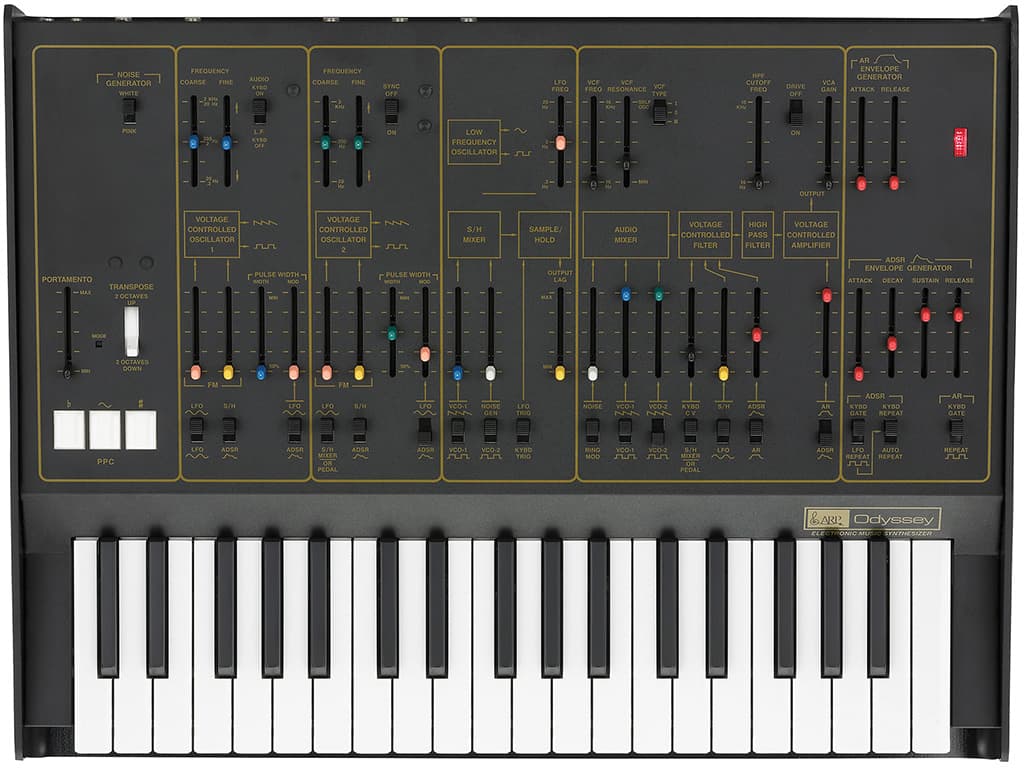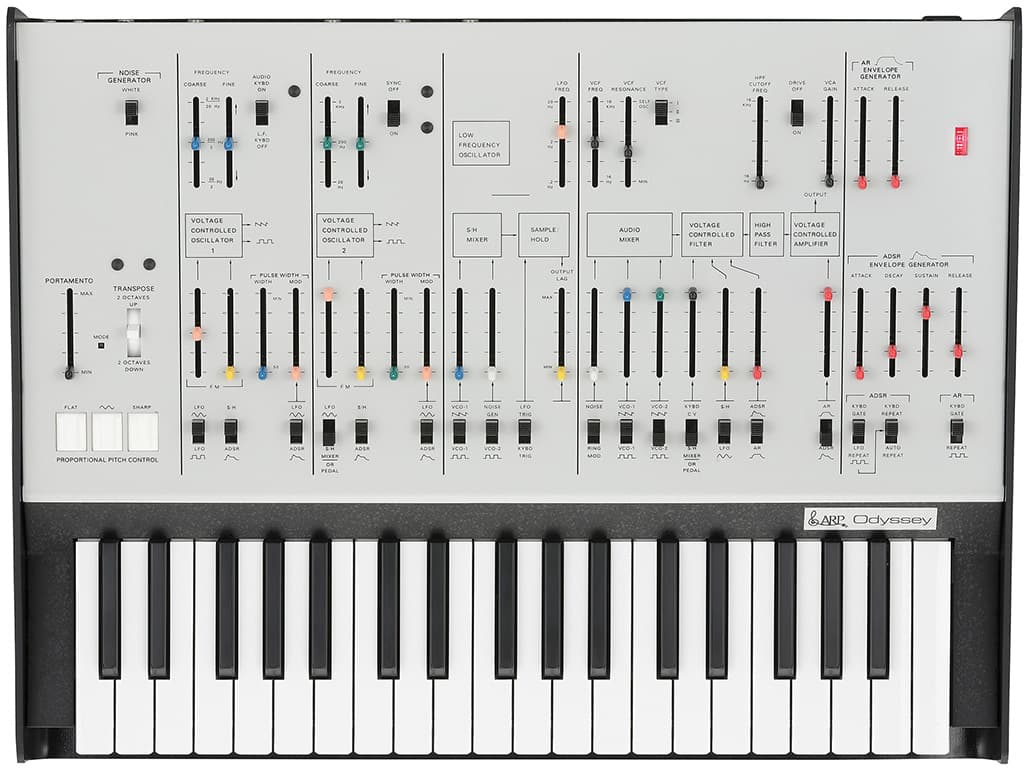
Review: Korg ARP Odyssey Analogue Synthesizer
A 3-in-1 ‘reissue’ of one of the hugest synths of the ‘70s.
Review: Peter Wavell
It was perhaps one of the more bizarre announcements of 2014. But when Korg announced it had teamed up with David Friend, co-founder and former president of ARP Instruments, to re-launch the classic early-’70s analogue monosynth, the ARP Odyssey, there was very little scepticism in the synth world. In large part, this was because the company had already proved with its MS20 Mini and MS20 Kit that it could accurately and successfully recreate vintage synths. The burning question was, would this (like Moog’s recent modular synths) be a clone of the original or would it (like the MS20s) be an emulation with changes and enhancements?
When the Odyssey finally appeared at the NAMM Show in Anaheim, California in January 2015, it proved to be very much the latter, with improvements and limitations in almost equal measure. Most noticeably, it’s based upon a mini-keyboard, which means that it won’t be of much use as a ‘live’ instrument for the many players who are accustomed to standard-width keyboards. Of course, the world has changed considerably since the 1970s, and mini-keys are no longer the preserve of toys — many lower-cost synths are now equipped with them because their owners use them as triggers rather than a means to play multiple notes per second during fiendishly complex keyboard solos. Nonetheless, it still seems a strange decision on Korg’s part, and one that’s going to limit the size of the market, although, to be fair, they may also pick up additional sales where space (or, rather, the lack of it) is a significant problem.
The second limitation is the new Odyssey’s MIDI specification. In short, it responds only to MIDI Note On/Off messages, which means that you can neither record nor replay performances that include pitch-bend or modulation. This seems to be a strange omission, and it demonstrates that, when designing the instrument, Korg’s engineers were concentrating less on the performing musician than they were on the sound designer for whom performance features are less of an issue.
DI-VINYL LOOK
These issues aside, Korg’s version is a beautiful recreation of the original instrument. The new version is dressed in the same wrap-around vinyl case of earlier Odysseys, but it’s available in three liveries that echo the Mk1 (white face), Mk2 (black and gold) and Mk3 (black and orange ‘Halloween’) versions of the original, all of which have the ‘Wow!’ factor that’s missing from so many modern instruments.
This beauty is more than skin deep. In particular, the faders (which are a constant source of frustration and failure on vintage Odysseys) are really smooth, and they make experimentation and sound creation a thing of joy. Also beneath the sexy exterior, Korg’s engineers have echoed what they did when designing the new MS-20s (which offer both the Korg35 and later OTA filters) by incorporating all three of the Odyssey’s filters: the 4023 from the Mk1, the 4035 from the earliest Mk2s, and the 4075 from the later Mk2s and Mk3s. Of course, this means that the new Odyssey is not a clone of any version of the original, and opening it up to look at the board reveals that it’s built using modern components and manufacturing techniques. But while the filters are not the perfect recreations Korg claim they are — contrary to what you might have read on various forums — pretty damn close (even at high resonance) and they succeed in emulating the brightness of the 4023, the warmth of the 4035 and the slightly muted character of the 4075.
The other thing to note about the physical design is the provision of the pressure pads that were introduced on the later Mk2s rather than the simple pitch bend knob of the earlier Odysseys. You can use the three pads to bend notes up and down, and to control the modulation depth, just as you would with a more conventional two-wheel arrangement or X/Y joystick. However, just as on the original synth, you need to apply a lot of pressure to obtain the desired effects, and I suspect that many players will, for the most part, ignore these.
NEED TO KNOW
FILTERING THE TRUTH
So, what of the sound? I compared a new model sporting the Mk3 livery to an original Odyssey, and I found it to be remarkably similar. It goes without saying that all of the features and functions are copied precisely from the original, so all I had to do was set the faders to the same relative positions (those on the new model are slightly shorter than those from the 1970s) and set the switches to the same positions, and play. In most cases, the sound was so close that a little adjustment was all that was needed to bring the sounds of the two instruments into line. Of course, the further you push your sounds into extreme realms of noise and effects, the more difficult it is to obtain exactly the same result, but even patches that used the more advanced functions such as FM, sample and hold, and the trigger/gate options attached to the dual envelope generators could be imitated to a very creditable degree, so Korg’s engineers should be applauded for this.
In addition to the three filter options, the new Odyssey offers a second ‘bonus’ function that wasn’t present on any previous version. The Drive switch boosts the signal between the filter (VCF) and audio signal amplifier (VCA) sections and, depending upon other factors, this can result in anything from a mild thickening of the sound to a significant rasp as the VCA input distorts and clips the signal. Some 1970s synths allowed you to overdrive their filter inputs or VCAs by accident, but it’s a great effect and nowadays you have to wonder why it was never offered by design in the early days of analogue synthesis. You also have to wonder why Korg implemented it as an on/off switch here, when a variable amount of drive controlled by a fader would have been more flexible.

PLAYING THE NEW ODYSSEY
Now it was time to put the new Odyssey through its paces. Ignoring the size of the keyboard, I was pleased to find that it retains the correct duophonic attributes of the original. This means that if you play two of more notes, VCO1 is allocated to the lowest, while VCO2 is allocated to the highest. This has much more significance than simply being able to pass two notes down a single filter/amplifier signal path. When playing, it’s very common for the last note and the next to overlap slightly as your fingers release one and press the next. On other synths, this can result in a note transition that’s slightly uneven or out of time with the music. On the Odyssey (both original and new) the result is a smoother transition as one of the oscillators plays the new note, to be joined a fraction of a second later by the second. This made playing the Odyssey a very different experience from playing its only significant competitor at the time, the Minimoog.
I was also pleased to find I was able to create a feedback loop by routing one of the Odyssey’s outputs back into its external signal input. This input was originally provided so you could use the Odyssey as an effects unit, filtering signals from other instruments and adding effects such as tremolo. But early on, players found that if you looped the synth’s output back into this input you could create a whole new range of effects, from gentle overdrive through to complete uncontrolled mayhem at high feedback levels. Due to the choice of I/O sockets, the new Odyssey makes it particularly easy to experiment with this, and the results can be amazing, especially when modified by the Drive.
I don’t like miniature keys so, to play the new Odyssey, I connected its MIDI In to the MIDI Out of a six-octave workstation. This was great, and allowed me to play Odyssey sounds over a wider range of keys than had ever been possible in the 1970s. But the lack of performance control proved to be more frustrating than I had imagined. (Like coffee and chocolate, you only realise how important pitch bend and modulation once they’re taken away from you.) So, given the limited MIDI spec, I think that I would be very tempted to use the new Odyssey as the sound source for simpler, sequenced lines, where the lack of pitch-bend and real-time control over the modulation depth are far less likely to matter. In addition, it’s going to be a great source of high quality samples, whether to play polyphonically from a suitable sampler or workstation, or as one-shot effects recorded specifically for the purpose. The other way to use it (and to overcome the MIDI limitations) would be to take the MIDI stream from the remote keyboard and convert this into analogue control signals. As well as an expression pedal input, the new Odyssey has a full complement of six CV, Trigger and Gate sockets (three In and three Out) so, with a suitable MIDI/CV converter, you could convert things such as pitch bend, modulation and aftertouch into appropriate changes in the CVs presented to the analogue synth.
If you’re thinking of using the new Odyssey live, or even just transporting it from studio to studio (or bedroom to bedroom) you’ll be delighted by the case in which it arrives. It’s light, it’s attractive and, while it might not stand up to the loving care of the baggage handlers at Kingsford Smith, it’s more than adequate for throwing onto the back seat of your car. It would be great if Korg’s initiative caused other manufacturers to consider supplying synths this way — it’s a huge improvement over a cardboard box, and an even bigger one over wrapping your instruments in blankets!
ODYSSEY, NO SHORT TRIP
Given its size, the Korg Odyssey may look like a bit of a toy but, sound-wise, it’s every bit as capable as a vintage Odyssey, and more. Notwithstanding the miniature keyboard, it can be a soloing synth, a bass synth, an imitator of orchestral instruments, a percussion synth, and a creator of extreme sounds and effects almost without peer. I can live with its two significant limitations — the miniature keyboard and the MIDI spec — you’ll find it to be an excellent synthesiser that can at times sounds indistinguishable from its forebears. If you can’t, you’ll have to hope the powers-that-be at Korg relent and offer a full-sized version (as they did with its MS20 Kit) sometime in the not-too-distant future.



















I don’t know about these latest Korg recreations, but the MS-20 Kit works like a charm. If Korg made a rackmount version (I need another MIDI controller like a hole in the head!) I would very likely buy one.
I have one of these new Oddys and I’m liking it a lot. It brings me back to a time in my youth spent in music stores driving the employees nuts with my experiments on their gear. I always wanted to take one home, but could never afford it.
I think that too much is made of the so-called “mini keys.” They’re not mini keys like in the MS20 mini, but rather “slim keys” which are slimmer than typical but nearly as long as “standard” keys. I understand that the standard for key size on various keyboard instruments has varied a great deal over the centuries in any case. I find that my technique with these keys needs a little practice, but I can still move along pretty well even with fairly demanding stuff. I’m no Keith Emerson, but the right hand for Bach’s 2 part invention in F is a cakewalk.